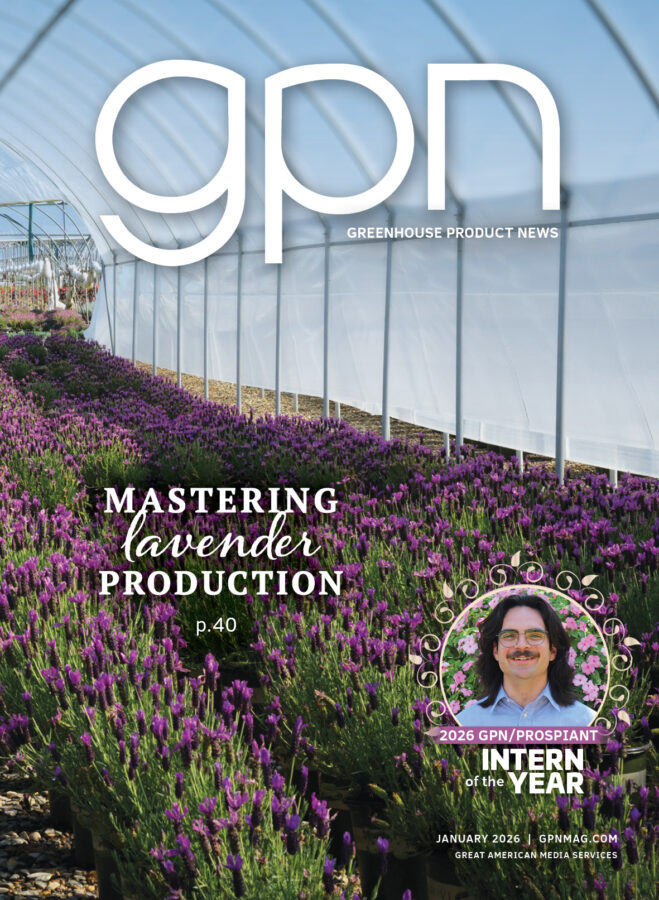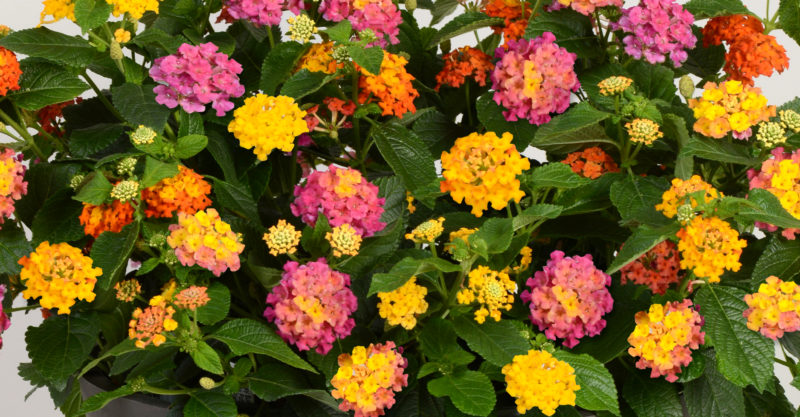
Celebrating Lantana!
Each year, the National Garden Bureau selects crops in various categories to honor and promote throughout the gardening season. This year, lantana was selected in the annuals category, and I certainly am not surprised. It seems over the past few years, lantana breeders have been working hard to bring colorful, resilient breakthroughs. We decided to discuss the strides made in lantana
development with members of the industry and get their take on this recognition. Here’s what they had to say.
GPN: Are you familiar with the National Garden Bureau’s “Year of” program? Do you take advantage of and promote the selected crops when they pertain to your business?
Brian Weesies, Mast Young Plants: I am aware of that program and at Mast Young Plants we look at it each year. We have been able to use it in years past. For instance, in 2019 it was the Year of the Dahlia and with that in mind we did a very large dahlia trial at our summer public gardens comparing all breeders’ lines of dahlias that we were able to get in as URCs or rooted liners.
Sarah Swofford, Ball FloraPlant: Yes, we are aware of the program. Ball FloraPlant and the breeding companies of Ball Horticultural Company promote the “Year of” selected crops each year by sharing our product photos with the team at NGB and our product management team often contributes editorial content. We also remind our customers about the “Year of” selected crops when relevant to our product launches. In The Gardens at Ball in West Chicago, Illinois, we post specific “Year of” signs next to featured plants.
Wendy Bergman, Syngenta Flowers: I was very thrilled about the news when it was announced at Cultivate that 2020 will be the Year of the Lantana. We are a memb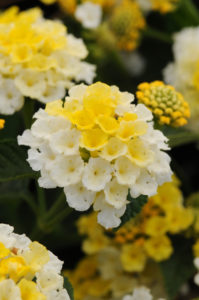 er of the National Garden Bureau, and we are always looking forward to participating in this program every year in to support and encourage gardening enthusiasts across the country.
er of the National Garden Bureau, and we are always looking forward to participating in this program every year in to support and encourage gardening enthusiasts across the country.
GPN: 2020 has been named “Year of the Lantana.” In your opinion, why do you think this crop was selected for the upcoming year?
Sarah: I grew up in Texas where lantana is a tried-and-true staple in gardens across the state. Fun fact: there’s even a town in Texas named Lantana! This crop has everything going for it: season-long flower power, ease of care and maintenance, bright and bold colors, strong heat tolerance. It’s also a key component to any butterfly garden, and with pollinator-friendly plants topping trends coast to coast, lantana is a must-have.
Wendy: There are so many reasons to love lantana! Lantana is a heat lover but also does very well in summer gardens throughout North America. They are available in a versatile range of colors and flower non-stop all season long. Lantana requires very little care, and once established, is quite drought resistant. They can add a bright pop of color to garden plantings, hanging baskets, porch pots or anywhere colorful flowers are desired.
Brian: This crop was a good choice due to the trend seen (and what we see in our young plant bookings); people want more and more summer performance out of the annuals they buy. We continue to see a decline in annuals like bacopa, diascia and nemesia or annuals that don’t hold up for a full season of color. With crops like lantana, we see them going all the way until first frost and offering good color. I had a pot of ‘Hot Blooded’ by my office door and I took a photo of it on Oct. 15, in Grand Rapids still looking good even though we already had a few light frosts.
GPN: What has been your role and experience in the development, marketing and/or sale of lantana?
Brian: At Mast Young Plants, we have a department that runs plant trials called our innovating department. We always trial new varieties for breed ers before they hit the market and give them feedback. We have a public trial garden where in the summer of 2019 we grew out the new varieties that breeders will hit retailers within the summer of 2020. This gives us a chance to see them and to allow retail and wholesale growers a chance to come and see them and decide which they prefer. We were able to work with Syngenta Flowers in 2019 and offer a pre-release of their 2020 variety, ‘Hot Blooded’. This exciting new variety sold very well as a pre-release and should be well received at retail in 2020.
ers before they hit the market and give them feedback. We have a public trial garden where in the summer of 2019 we grew out the new varieties that breeders will hit retailers within the summer of 2020. This gives us a chance to see them and to allow retail and wholesale growers a chance to come and see them and decide which they prefer. We were able to work with Syngenta Flowers in 2019 and offer a pre-release of their 2020 variety, ‘Hot Blooded’. This exciting new variety sold very well as a pre-release and should be well received at retail in 2020.
Wendy: I’m a floriculturist and flower breeder. I play “the birds and the bees” with lantana to invent and develop new varieties that possess superior garden performance for our customers. I collaborate with marketing, sales and consumers to make sure we are on the right track to develop and deliver the best new varieties to the market.
Sarah: I am the lantana product manager for Ball FloraPlant. I manage the life cycle of a lantana variety in our pipeline from its start up until the point it becomes a commercial introduction. Simply put, I help bring new lantana varieties to the commercial market!
Our lantana breeder creates new, experimental lantana varieties. Ball FloraPlant then trials these varieties for multiple years to make sure they meet our performance standards. Plants get trialed in locations across North America — in gardens and greenhouses. Many of the plants we trial do not meet our standards and do not move forward, but a few do. It’s rewarding and exciting to see the progression of a plant: From an initial selection by our breeder, to years of consistent trialing, to a plant offered for sale to growers and consumers grown in people’s gardens across the globe! Our breeder often sends me pictures he finds of people growing and promoting the varieties he bred. Getting to be a part of that gives me a great sense of pride.
GPN: What changes and innovations have you seen in recent years in the lantana category?
Sarah: The recent breeding in this crop has given it more variety and versatility. Some new breeding has resulted in plants with highly improved branching. Better branching creates plants that are easier to manage for both growers and gardeners. There are also more size options in the crop. Lantana offered in the past was extremely vigorous, almost shrub size when grown in warm Southern regions. Newer compact lantana series like the Little Lucky series are now tidier and easier to manage, allowing them to be grown in containers and baskets.
Bright and bold new colors are now offered in this crop as well, compared to a more limited color range of primarily white, gold and purple in the past. Also, in Southern regions, lantana can be invasive. The new certified sterile Bloomify series of lantana bred by the University of Florida has been a game changer for those markets.
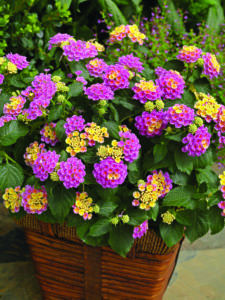 Wendy: We have made significant progress in improving plant habits, making
Wendy: We have made significant progress in improving plant habits, making
them bushier and denser, with larger flowers. Additionally, we’ve worked hard to ensure continual blooming throughout the gardening season.
In recent years, we have developed and introduced several sterile lantana varieties that are unlikely to outcross with native species of lantana.
This is important for areas of the country, particularly Florida, where there is concern about losing native species through outcrossing with the commercially produced.
Brian: I have seen mostly habit and color changes. The old traditional lantana varieties were more of a landscape plant that spread and grew quite tall. The new breeding has made lantana much more compact and controlled. It has also brought out more vivid colors.
One issue that growers have dealt with regarding lantana is cycling of flowers. Syngenta has done quite a bit of research on this and has tried to crack the code on what causes it.
The breeding has also focused on the plants being sterile. This helps for continuous flowering and I am told it also helps in the South as the seed pods can be eaten by birds and then spread around, making the plant a noxious weed
in some parts of the country (not up here in Michigan where I am looking at 6 inches of snow out my window on Nov. 13!).
GPN: How can growers capitalize on lantana?
Wendy: The great thing is there is a lantana variety for every pot size, and they are reasonably accessible and fast to grow in any garden.
Sarah: The newer lantana genetics on the market give growers the ability to choose the lantana size option that works best in the region they grow in or supply. In Southern regions where vigorous lantana can become an unruly monster, a more compact variety is easier to manage and will save time for growers. Alternatively, in regions where the growing season may have less light and heat, a more vigorous lantana variety could be grown more quickly, saving time. These time savers mean a quicker bench turn, offering more stock for retail and more money for growers!
The new breeding for better branching allows fewer plants per pot required; this translates to savings for a grower who can create a quality final product with fewer inputs.
Growers should also market lantana as a butterfly magnet and make sure their retailers identify these plants in their pollinator department. It will encourage a different type of gardener to give lantana a try!
Brian: Use lantana for late spring and summer sales. Transition out the spring annuals like petunias and verbenas, and put lantana on the shelves to sell, as they will hold up in the heat and will do well for the customers all summer long.
GPN: What are some new/unique/special recent lantana introductions? What are their characteristics?
Sarah: Bloomify Mango, Red and Rose. The Bloomify series is the first certified sterile lantana on the market! Sterility is important in Southern markets. Many sterile plants also flower longer and have larger flowers than their non-sterile counterparts — this is true in the Bloomify series.
Wendy: Hot Blooded is the single most exciting lantana introduction I’ve experienced in my career. This plant covers all the bases. The flowers are incredibly red, the plant is perfectly mounded, it’s always covered in blooms AND it’s sterile.
This year we introduced the new series Bandolero. The plants are tightly mounded, covered in bright flowers, and grow up to 25-30% larger than our very successful Bandana series. Bandolero is perfect for the grower wanting to produce in larger pots for retail, and for the consumer to achieve instant color in their plantings.
Brian: The most recent and most unique introductions have come from Ball and Syngenta. Ball was the first to really push the sterility of the flowers and came out with a series called Bloomify, which now has three colors.
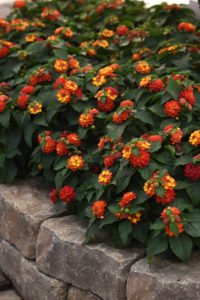 Syngenta’s new release for 2020 Hot Blooded is a one-off that they don’t put it in either the Bandana or the Bandolero series. I’ve heard it said about this variety, “If you pick just one, pick this one!” I had the privilege of seeing it in the Syngenta field trials in Gilroy, California, in the summer of 2018 and it was one of those plants you noticed from 100 feet away and had to walk over and see up close.
Syngenta’s new release for 2020 Hot Blooded is a one-off that they don’t put it in either the Bandana or the Bandolero series. I’ve heard it said about this variety, “If you pick just one, pick this one!” I had the privilege of seeing it in the Syngenta field trials in Gilroy, California, in the summer of 2018 and it was one of those plants you noticed from 100 feet away and had to walk over and see up close.
GPN: Do you know of anything in the pipeline in the lantana category that you can share?
Brian: I am fortunate enough to see the breeding pipeline from multiple breeders, but I don’t feel comfortable sharing what I have seen in their private trials. I think it is fair to say that breeders are taking note of the increase in sales of this genera and are doing more breeding.
Danziger came out with a full line for 2020 and one that stood out in their Gem series this summer in our trial garden was Compact Orange Fire. It did excellent and as the name stated it is compact, so it’s good for smaller containers or small space gardens.
Wendy: We have an engaging pipeline for lantana to fill in the color range in all four series Bandito, Bandana, Bandolero and Landscape Bandana. At the same time, we are also working on new sterile varieties like ‘Hot Blooded’ in exciting new colors. Stay tuned!
Sarah: Coming soon we have new colors for our Bloomify series and a new trailing lantana variety that is an improvement over a well-known variety long standing in the Southern lantana market.









 Video Library
Video Library 

















